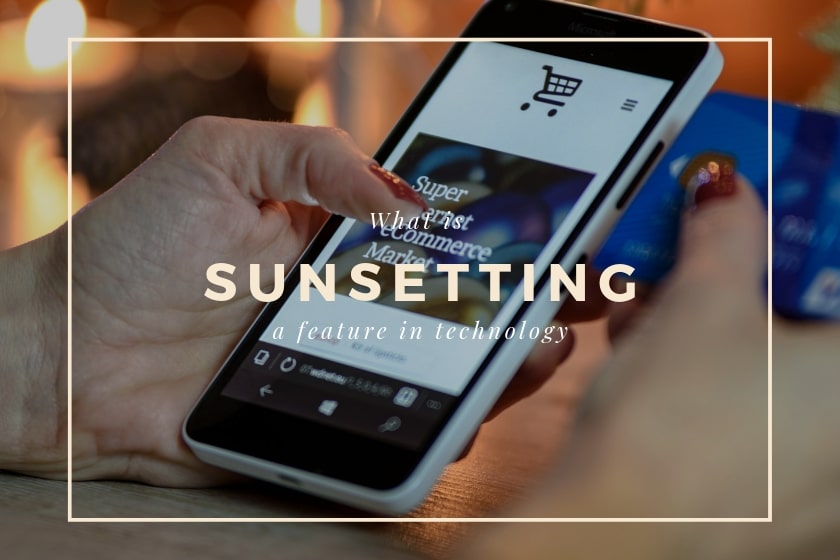Sunsetting Technology: Navigating the Evolution of Innovation
Sunsetting technology is a constant in our ever-evolving digital landscape. As new innovations emerge, older technologies inevitably reach their end of life, often leaving behind a trail of questions about […]

Sunsetting technology is a constant in our ever-evolving digital landscape. As new innovations emerge, older technologies inevitably reach their end of life, often leaving behind a trail of questions about obsolescence, support, and the future of our digital world. The sunsetting of technology isn’t just a technological event; it’s a complex process with far-reaching economic, social, and environmental consequences.
From the demise of floppy disks to the phasing out of legacy software, sunsetting technology has shaped our digital past and continues to influence our present and future. Understanding the factors that drive this process, the impacts it has on individuals and organizations, and the strategies for navigating this inevitable transition is crucial for navigating the ever-changing technological landscape.
Defining Sunsetting Technology

Sunsetting technology is a natural process within the ever-evolving landscape of technology. It involves the gradual phasing out of a technology as it becomes obsolete, lacks support, or is replaced by newer, more efficient alternatives. This process is crucial for maintaining technological advancement and ensuring that resources are allocated to the most promising innovations.
Factors Contributing to Technology Sunsetting
Several factors contribute to a technology’s sunsetting. Understanding these factors helps us comprehend why certain technologies fade into the background while others persist.
- Obsolescence: As technology advances, older technologies become outdated and unable to meet the demands of evolving needs. For example, the transition from floppy disks to USB drives and cloud storage exemplifies obsolescence in data storage.
- Lack of Support: When a technology’s manufacturer ceases to provide updates, security patches, or technical support, it becomes increasingly vulnerable to security risks and malfunctions. This lack of support often leads to a technology’s sunsetting. For instance, the discontinuation of support for older versions of Windows operating systems by Microsoft has resulted in their sunsetting.
- Emerging Alternatives: The emergence of superior alternatives with enhanced capabilities and efficiency can render existing technologies obsolete. For example, the rise of smartphones with advanced features has led to the decline of traditional feature phones.
Examples of Sunsetting Technologies
Sunsetting technologies are prevalent across various industries, impacting software, hardware, and communication. Here are some examples:
- Software: Adobe Flash Player, once a dominant platform for multimedia content, has been sunsetted due to security vulnerabilities and the rise of HTML5.
- Hardware: The gradual phasing out of traditional desktop computers in favor of laptops and tablets exemplifies hardware sunsetting.
- Communication: The decline of landline telephones as mobile phones became ubiquitous showcases the sunsetting of communication technologies.
Strategies for Managing Sunsetting Technology
Sunset technologies are those that are no longer supported by their vendors, and it’s crucial for organizations to have a well-defined strategy for managing this transition. Failing to do so can lead to significant disruptions, security vulnerabilities, and financial losses.
Planning for Technology Sunsetting
Planning is paramount to a smooth transition away from sunsetting technologies. Organizations must carefully consider the impact of the sunsetting technology on their operations and develop a comprehensive plan that addresses all aspects of the transition.
- Communication with stakeholders: Open and transparent communication with all stakeholders is crucial. This includes informing employees, customers, and partners about the sunsetting technology, the timeline for the transition, and the impact on their operations. Effective communication can help manage expectations, reduce resistance, and ensure a smooth transition.
- Data migration: Data migration is a critical step in the sunsetting process. Organizations must carefully plan and execute the migration of data from the sunsetting technology to a new platform. This involves identifying the data that needs to be migrated, developing a data migration plan, and testing the migration process to ensure data integrity. Data migration can be complex, and organizations should consider using specialized tools and services to ensure a successful migration.
- Training: Organizations must provide adequate training to employees on the new technology that will replace the sunsetting technology. This includes training on how to use the new technology, how to access and manage data, and how to troubleshoot any issues. Training should be tailored to the specific needs of employees and should be delivered in a format that is engaging and effective.
Phased Implementation of New Technologies
Phased implementation is a common strategy for managing the transition away from sunsetting technologies. This approach involves gradually introducing the new technology in stages, allowing organizations to test and validate the new technology before fully deploying it.
- Pilot projects: Pilot projects are a great way to test the new technology in a controlled environment before full-scale deployment. This allows organizations to identify and address any issues or challenges before they impact the entire organization. Pilot projects should involve a representative sample of users and should be carefully monitored to gather feedback and identify any potential problems.
- Parallel operation: Parallel operation involves running both the sunsetting technology and the new technology simultaneously. This allows organizations to gradually transition users to the new technology while ensuring that they still have access to the legacy system. Parallel operation can be resource-intensive, but it can help reduce the risk of disruptions and ensure a smooth transition.
Extended Support for Legacy Systems
In some cases, organizations may need to extend support for legacy systems while they transition to a new technology. This can be necessary if the new technology is not yet fully mature or if the organization has critical applications that rely on the legacy system.
Organizations can consider using third-party vendors to provide extended support for legacy systems.
Ethical Considerations of Sunsetting Technology

Sunsetting technology, while often necessary for progress, raises ethical concerns that need careful consideration. The process can have significant implications for users, particularly vulnerable populations, and requires responsible planning and execution to mitigate potential harm.
Responsibility to Provide Adequate Support for Users
Ensuring adequate support for users during the sunsetting process is crucial to minimize disruption and prevent digital exclusion. This involves providing clear and timely communication about the sunsetting timeline, offering alternative solutions or upgrades, and providing technical assistance to help users transition.
- Transparency and Communication: Companies must be transparent about their sunsetting plans, clearly communicating the timeline, reasons for sunsetting, and available alternatives. This allows users to plan accordingly and explore options.
- Extended Support: Providing extended support, including maintenance, security updates, and technical assistance, for a reasonable period after the sunsetting date helps users transition smoothly. This is particularly important for critical systems or those used by vulnerable populations.
- Alternative Solutions: Offering viable alternatives, such as upgraded versions, compatible software, or alternative platforms, allows users to continue accessing the necessary functionality. This minimizes disruption and prevents users from being left behind.
Potential for Digital Exclusion
Sunsetting technology can contribute to digital exclusion if not managed carefully. This occurs when users lack access to the necessary resources, skills, or support to transition to new technologies, leaving them behind in a digitally evolving world.
- Accessibility Considerations: Sunsetting technology without considering accessibility needs can disproportionately impact individuals with disabilities who rely on specific features or functionalities. Companies must ensure that alternatives are equally accessible to all users.
- Digital Literacy and Skills: Sunsetting technology without adequate training or support can leave users struggling to adapt to new systems, especially those with limited digital literacy. Providing training resources and support is essential to bridge the digital divide.
- Economic Impact: Sunsetting technology can have economic consequences, particularly for individuals and businesses that rely on outdated systems. Companies should consider providing financial assistance or extended support to mitigate the impact on vulnerable groups.
Impact on Vulnerable Populations
Vulnerable populations, including the elderly, low-income individuals, and those with limited digital literacy, are particularly susceptible to the negative impacts of sunsetting technology. They may lack the resources, skills, or support to transition to new technologies, leading to digital exclusion and further marginalization.
- Elderly and Seniors: Sunsetting technology can leave elderly individuals isolated and unable to access essential services or connect with loved ones if they lack the skills or resources to adopt new technologies. Companies must prioritize their needs and provide accessible alternatives.
- Low-Income Communities: Individuals in low-income communities may face financial barriers to upgrading devices or accessing internet services, making it difficult to transition to new technologies. Companies should consider offering affordable solutions or subsidies to bridge the digital divide.
- Individuals with Disabilities: Sunsetting technology without considering accessibility needs can create significant challenges for individuals with disabilities. Companies must ensure that alternatives are equally accessible and provide appropriate support to ensure inclusivity.
Role of Government and Industry in Addressing Ethical Challenges
Government and industry play crucial roles in mitigating the ethical challenges associated with sunsetting technology. Governments can establish regulations and guidelines to ensure responsible sunsetting practices, while industry can adopt ethical frameworks and best practices to minimize harm.
- Government Regulation: Governments can enact legislation that requires companies to provide adequate notice, support, and alternatives for users during the sunsetting process. This can help ensure a fair and equitable transition for all.
- Industry Best Practices: Companies can adopt ethical frameworks and best practices for sunsetting technology, including transparency, user-centered design, and extended support. Industry associations can also develop guidelines and standards to promote responsible sunsetting practices.
- Public Awareness and Education: Governments and industry can collaborate on public awareness campaigns to educate users about sunsetting technology, provide guidance on transitioning to new technologies, and address potential challenges.
Best Practices for Ensuring a Responsible and Ethical Approach to Technology Sunsetting
Adopting a responsible and ethical approach to technology sunsetting involves careful planning, communication, and support for users. Companies should prioritize user needs, consider potential impacts, and implement strategies to mitigate harm.
- Clear and Timely Communication: Communicate sunsetting plans clearly and well in advance, providing detailed information about the timeline, reasons for sunsetting, and available alternatives.
- Extended Support and Maintenance: Provide extended support, including maintenance, security updates, and technical assistance, for a reasonable period after the sunsetting date to allow users to transition smoothly.
- Accessibility Considerations: Ensure that alternatives are accessible to all users, including individuals with disabilities, and provide appropriate support to facilitate the transition.
- Digital Literacy Training: Offer training resources and support to help users develop the skills and knowledge necessary to adopt new technologies.
- Financial Assistance and Support: Consider providing financial assistance or subsidies to help vulnerable populations afford new devices or services.
- Collaboration with Stakeholders: Engage with users, industry stakeholders, and government agencies to address concerns and ensure a responsible and ethical sunsetting process.
Future Trends in Sunsetting Technology
The rapid evolution of technology is transforming the landscape of technology sunsetting. Organizations and individuals must adapt to these changes to effectively manage the lifecycle of their technology assets.
The Increasing Pace of Innovation
The pace of innovation is accelerating, with new technologies emerging at an unprecedented rate. This rapid evolution creates a dynamic environment where technologies quickly become obsolete. As a result, organizations need to be more proactive in sunsetting outdated technologies to stay competitive and avoid security vulnerabilities.
The Rise of Cloud Computing, Sunsetting technology
Cloud computing is revolutionizing how organizations manage their IT infrastructure. By shifting to cloud-based services, organizations can access the latest technologies on demand, reducing the need for on-premises infrastructure and minimizing the risk of technology obsolescence. This shift towards cloud computing will likely lead to a more dynamic and agile approach to technology sunsetting, with organizations able to quickly adapt to new technologies and business needs.
The Emergence of New Technologies
The emergence of new technologies, such as artificial intelligence (AI), blockchain, and quantum computing, will continue to drive the evolution of technology sunsetting. These technologies have the potential to disrupt existing industries and create new opportunities. As these technologies mature, organizations will need to evaluate their existing infrastructure and sunset outdated technologies to embrace the benefits of these advancements.
Implications for Organizations and Individuals
The trends discussed above have significant implications for organizations and individuals.
- Organizations must develop a strategic approach to technology sunsetting that aligns with their business objectives and risk tolerance.
- Organizations need to invest in continuous learning and development to keep up with the latest technologies and best practices.
- Individuals need to be adaptable and embrace lifelong learning to stay relevant in the rapidly changing technological landscape.
Navigating the Future Landscape of Technology Sunsetting
Organizations and individuals can navigate the future landscape of technology sunsetting by:
- Adopting a proactive approach to technology sunsetting: Regularly assess the technology portfolio and identify outdated technologies that need to be sunsetted.
- Developing a comprehensive sunsetting plan: This plan should Artikel the process for sunsetting technology, including data migration, system decommissioning, and user training.
- Investing in technology and skills development: Stay informed about the latest technologies and invest in training to acquire the necessary skills to manage the evolving technology landscape.
- Collaborating with technology partners: Engage with technology partners to gain insights and leverage their expertise in managing technology sunsetting processes.
Final Thoughts
Sunsetting technology is an inevitable part of progress, but it’s a process that requires careful planning and responsible management. As we embrace the future of technology, we must be mindful of the impact on those affected by sunsetting, ensuring that the transition is equitable, sustainable, and ethically sound. By understanding the complexities of sunsetting technology, we can better navigate the challenges and opportunities that lie ahead, ensuring a future where innovation and progress are balanced with responsible stewardship of our digital resources.
As technology evolves, older systems inevitably reach their end-of-life, becoming what we call “sunsetting technology.” This can pose challenges, especially when it comes to security. Thankfully, advanced protection technologies are available to help bridge the gap, ensuring continued safety even as legacy systems sunset.
By embracing these advancements, we can manage the transition smoothly and maintain robust security in the face of changing technology landscapes.








